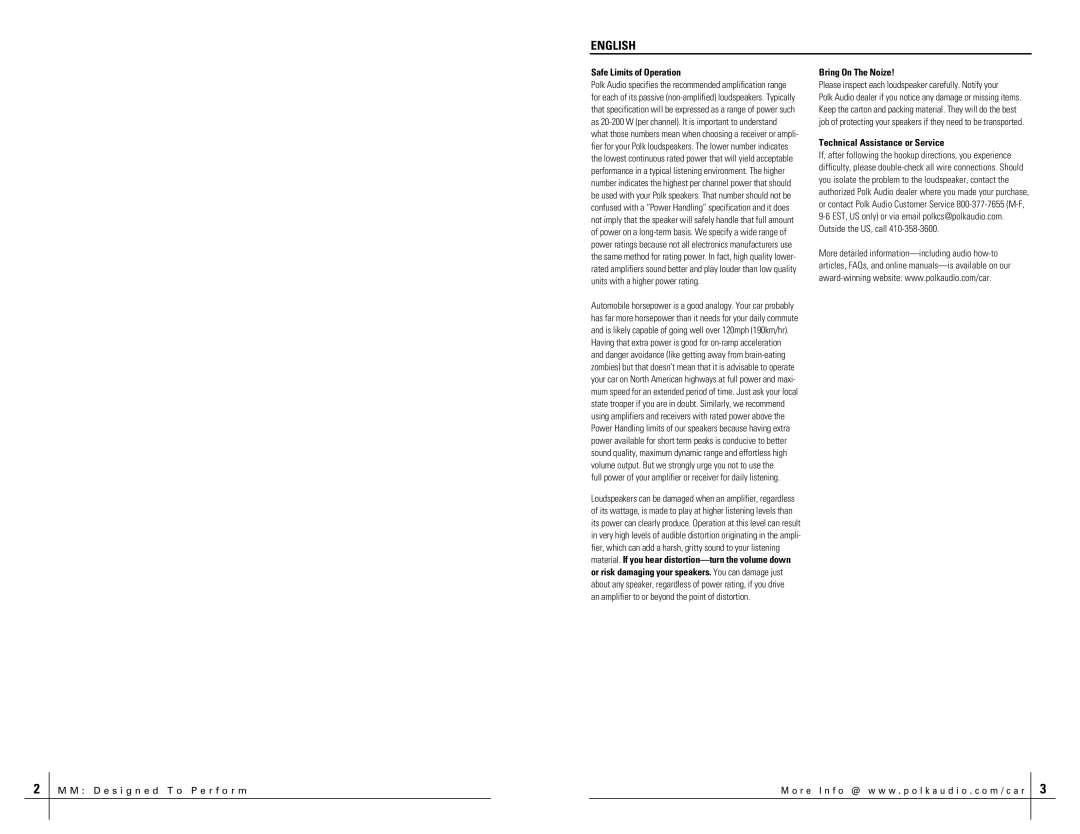Safe Limits of Operation
Polk Audio specifies the recommended amplification range for each of its passive (non-amplified) loudspeakers. Typically that specification will be expressed as a range of power such as 20-200 W (per channel). It is important to understand what those numbers mean when choosing a receiver or ampli- fier for your Polk loudspeakers. The lower number indicates the lowest continuous rated power that will yield acceptable performance in a typical listening environment. The higher number indicates the highest per channel power that should be used with your Polk speakers. That number should not be confused with a “Power Handling” specification and it does not imply that the speaker will safely handle that full amount of power on a long-term basis. We specify a wide range of power ratings because not all electronics manufacturers use the same method for rating power. In fact, high quality lower- rated amplifiers sound better and play louder than low quality units with a higher power rating.
Automobile horsepower is a good analogy. Your car probably has far more horsepower than it needs for your daily commute and is likely capable of going well over 120mph (190km/hr). Having that extra power is good for on-ramp acceleration and danger avoidance (like getting away from brain-eating zombies) but that doesn’t mean that it is advisable to operate your car on North American highways at full power and maxi- mum speed for an extended period of time. Just ask your local state trooper if you are in doubt. Similarly, we recommend using amplifiers and receivers with rated power above the Power Handling limits of our speakers because having extra power available for short term peaks is conducive to better sound quality, maximum dynamic range and effortless high volume output. But we strongly urge you not to use the
full power of your amplifier or receiver for daily listening.
Loudspeakers can be damaged when an amplifier, regardless of its wattage, is made to play at higher listening levels than its power can clearly produce. Operation at this level can result in very high levels of audible distortion originating in the ampli- fier, which can add a harsh, gritty sound to your listening material. If you hear distortion—turn the volume down or risk damaging your speakers. You can damage just about any speaker, regardless of power rating, if you drive
an amplifier to or beyond the point of distortion.
Bring On The Noize!
Please inspect each loudspeaker carefully. Notify your
Polk Audio dealer if you notice any damage or missing items. Keep the carton and packing material. They will do the best job of protecting your speakers if they need to be transported.
Technical Assistance or Service
If, after following the hookup directions, you experience difficulty, please double-check all wire connections. Should you isolate the problem to the loudspeaker, contact the authorized Polk Audio dealer where you made your purchase, or contact Polk Audio Customer Service 800-377-7655 (M-F, 9-6 EST, US only) or via email polkcs@polkaudio.com. Outside the US, call 410-358-3600.
More detailed information—including audio how-to articles, FAQs, and online manuals—is available on our award-winning website: www.polkaudio.com/car.

